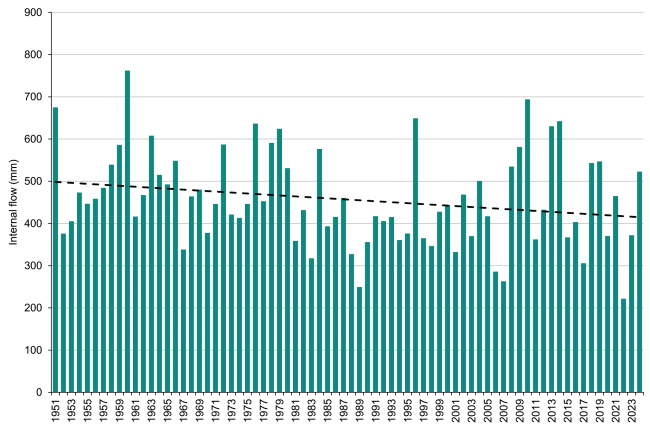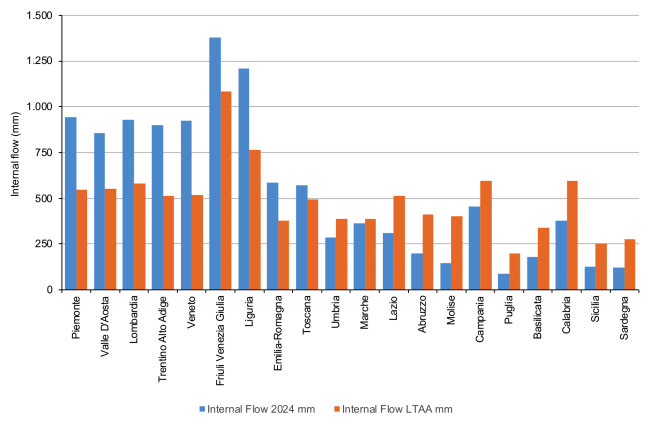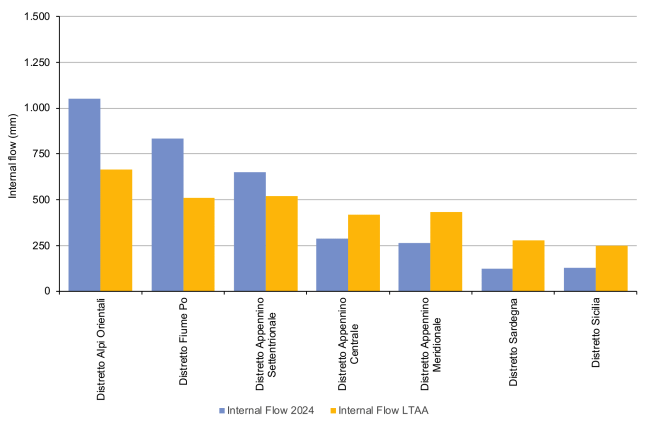Panel 1
Giovanni Braca, Stefano Mariani, Robertino Tropeano
The internal flow indicator provides the annual estimate, expressed in mm, of the amount of renewable water resource that is naturally produced in a given territory due to the effect of precipitation falling in the same territory. The indicator is calculated for each year from 1951 to 2024.
In 2024 the value of the indicator at national level was 522.8 mm, corresponding to 157.9 billion cubic meters. The average value of the indicator in the national territory of the last thirty years of climate 1991–2020 is 440.9 mm, corresponding to a volume of 133.5 billion cubic meters, while the long-term average 1951–2024 (so-called LTAA-Long-Term Annual Average) is 457.5 mm, corresponding to 138.2 billion cubic meters.
2024 was characterized by a positive anomaly compared to the long-term estimate (+14.3%), as well as compared to the last thirty years of the climatological period (+18.3%). This positive anomaly is attributable to the high rainfall in the North, while in the territories of Central and Southern Italy and the major islands a persistent drought has been observed. However, at the national level, the availability of renewable water resources continues to show, from 1951 to the present, a statistically significant negative trend.
The indicator constitutes, according to the OECD/Eurostat definition, the total annual volume of the surface outflow generated, under natural conditions in a given territory, exclusively from precipitation. It can also be expressed as the difference between annual meteoric inflow and annual real evapotranspiration. The hydrological variables, on the basis of which the indicator is calculated, by their nature can be influenced by climate change so the same indicator can be subject in turn to climate change.
The indicator is requested by OECD/Eurostat in the Joint Questionnaire on Inland Waters for the definition of water resource statistics. It also contributes to the calculation of the 6.4.2 indicator of the Sustainable Development Goals (SDGS) called "Level of water stress: freshwater withdrawal as a proportion of freshwater resources" (https://www.sdg6monitoring.org/indicator-642/2) and the Water Exploitation Index plus indicator (WEI+; see the same name of the same name in the environmental theme "Water source and balance").
Provide an assessment of the amount of renewable water resource that, of course, is produced in a given territory annually and which is available for the needs of ecosystems and for different uses (civil, agricultural, industrial, etc.).
- D.Lgs. n. 152/2006, recante "Norme in materia ambientale" (G.U. Serie Generale n. 88 del 14-04-2006 - Suppl. Ordinario n. 96), che recepisce la Direttiva Quadro sulle Acque 2000/60/CE.
- D.L. n. 39/2023, recante “Disposizioni urgenti per il contrasto della scarsità idrica e per il potenziamento e l'adeguamento delle infrastrutture idriche” (G.U. Serie Generale n. 88 del 14-04-2023), convertito con modificazioni dalla L. n. 68/2023 (G.U. Serie Generale n. 136 del 13-06-2023), in cui l’istituzione degli Osservatori distrettuali permanenti sugli utilizzi idrici presso le Autorità di bacino distrettuali è stata disposta da una norma primaria.
- European Water Resilience Strategy, adottata dalla Commissione europea il 4 giugno 2025.
Panel 2
- Braca, G., Mariani, S., Lastoria, B., Tropeano, R., Casaioli, M., Piva, F., Marchetti, G., e Bussettini, M., 2024: Bilancio idrologico nazionale: stime BIGBANG e indicatori sulla risorsa idrica. Aggiornamento al 2023. Rapporti n. 401/2024, ISPRA, Roma. Disponibile online all’indirizzo: https://www.isprambiente.gov.it/it/pubblicazioni/rapporti/bilancio-idrologico-nazionale-stime-bigbang-e-indicatori-sulla-risorsa-idrica-aggiornamento-al-2023.
- Braca, G., Mariani, S., Lastoria, B., Piva, F., Archi, F., Botto, A., Casaioli, M., Forte, T., Marchetti, G., Peruzzi, C., Tropeano, R., Vendetti, C., e Bussettini, M., 2023: Bilancio idrologico nazionale: focus su siccità e disponibilità naturale della risorsa idrica rinnovabile. Aggiornamento al 2022. Istituto Superiore per la Protezione e la Ricerca Ambientale. Rapporti n. 388/2023, Roma. Disponibile online all'indirizzo: https://www.isprambiente.gov.it/it/pubblicazioni/rapporti/bilancio-idrologico-nazionale-focus-su-siccita-e-disponibilita-naturale-della-risorsa-idrica-rinnovabile-aggiornamento-al-2022.
- Braca, G., Bussettini, M., Lastoria, B., Mariani, S., e Piva, F., 2021: Il Bilancio Idrologico Gis BAsed a scala Nazionale su Griglia regolare – BIGBANG: metodologia e stime. Rapporto sulla disponibilità naturale della risorsa idrica. Istituto Superiore per la Protezione e la Ricerca Ambientale, Rapporti 339/21, Roma. Disponibile online all’indirizzo: https://www.isprambiente.gov.it/it/pubblicazioni/rapporti/il-bilancio-idrologico-gis-based-a-scala-nazionale-su-griglia-regolare-bigbang.
- FAO, ISPRA & Istat, 2023: A disaggregation of indicator 6.4.2 “Level of water stress: freshwater withdrawal as a proportion of available freshwater resources” at river basin district level in Italy. SDG 6.4 Monitoring Sustainable Use of Water Resources Papers. Rome, FAO. Disponibile online all'indirizzo: https://doi.org/10.4060/cc5037en.
- Mariani, S., Braca, G., Lastoria, B., Tropeano, R., Casaioli, M., Piva, F., Bussettini, M., 2024: “Il bilancio idrologico, la disponibilità di risorsa idrica e il bilancio idrico”, in Siccità, scarsità e crisi idriche, Emanuele Romano, Ivan Portoghese (a cura di), Habitat signa 1, 29-46. Roma: Cnr Edizioni. Disponibile online all’indirizzo: https://www.cnr.it/sites/default/files/public/media/attivita/editoria/SiccitaInterattivo_ver2.pdf.
- OECD/Eurostat, 2021, Data Collection Manual for the OECD/Eurostat Joint Questionnaire on Inland Waters and Eurostat Regional Water Questionnaire Concepts, definitions, current practices, evaluations and recommendations, Version 4.1.
- SNPA, 2024: Il clima in Italia nel 2023. Report SNPA n. 42/2024. Disponibile online all’indirizzo: https://www.snpambiente.it/snpa/il-clima-in-italia-nel-2023/.
- SNPA, 2023: Il clima in Italia nel 2022. Report SNPA n. 36/2023. Disponibile online all'indirizzo: https://www.snpambiente.it/2023/07/20/il-clima-in-italia-nel-2022/.
- SNPA, 2021: Rapporto sugli indicatori di impatto dei cambiamenti climatici – Edizione 2021. Report SNPA n. 21/2021. Disponibile online all'indirizzo: https://www.snpambiente.it/2021/06/30/rapporto-sugli-indicatori-di-impatto-dei-cambiamenti-climatici-edizione-2021/.
The indicator is built at the monthly scale on the basis of estimates made with the national hydrological budget model BIGBANG, version 9.0, of ISPRA, on the basis of official data produced at national and local level, and subsequently aggregated to the annual scale. This involves the loss of information from the intra-annual distribution of water resources. In addition, previously published estimates, referring to earlier versions of the BIGBANG model, may have slight deviations from the estimates of the latest version available as some data or schematizations underlying the model may have improved. Correct comparisons between the values of the indicator must therefore be made using the same version of the BIGBANG model.
The indicator could be improved by adopting a more robust scheme in the BIGBANG budget model for the assessment of potential evapotranspiration, but which nevertheless requires much more basic data, currently not available for the whole of the Italian territory and for the entire period 1951–2024.
Data quality assessment
ISPRA
JRC (Joint Research Centre)
Regional hydro-meteorological services and autonomous provinces
The precipitation and temperature data used are mainly those collected and published by the regional and provincial structures to which, according to Article 92 of Legislative Decree no. 112 of 31 March 1998, the functions and tasks of the peripheral offices of the National Hydrographic and Tire Service (SIMN, now merged into ISPRA) of the Department for National Technical Services, were transferred. The precipitation data are collected directly from the regional structures and autonomous provinces, while for the temperature the maps produced under the SCIA system of ISPRA (http://www.scia.isprambiente.it) are used. The precipitation and temperature data aggregated to the monthly scale on the regular BIGBANG grid of resolution 1 km, which covers the entire national territory, are available on the Groupware portal of ISPRA (https://groupware.sinanet.isprambiente.it/bigbang-data/library/bigbang-90). The data on the hydraulic characteristics of the soils are accessible (subject to registration) to the JRC/ESDAC portal (http://esdac.jrc.ec.europa.eu/content/lucas-2009-topsoil-data). For the permeability data of hydrogeological complexes, a new permeability paper produced by ISPRA was used.
National
1951–2024
Indicator assessment
The estimate of the indicator from 1951 to 2024 is carried out through the national water balance model on a monthly scale developed by ISPRA, called BIGBANG-Billion Bike Hiriological Gis BAsed on a National Scale on Regular Grid, version 9.0, which evaluates the indicator as a difference between the liquid inflows, derived from the spatial interpolation of timed precipitation data recorded by the networks in situ, and the evaporation of the waterway.
Among the geospatial layers used in the calculation of the hydrological balance, it is relevant for the evaluation of the internal flow the permeability of hydrogeological complexes.
The indicator is calculated from the monthly evaluation on a regular grid of 1 km resolution that covers the entire national territory and aggregated to the annual scale.
In 2024 the annual value of the internal flow, or the total renewable water resource, on a national scale is estimated at 522.8 mm, corresponding to 157.9 billion cubic meters.
During 2024 there was a significant recovery in Italy compared to both the annual availability of water resources in 2023 (availability estimated at 372.2 mm), and at the historical low, from 1951 to today, estimated in 2022 at 67.0 billion cubic meters (-50% compared to the last thirty years of the climate). 2024 marks an increase in the national availability of water resources of 14.3% compared to the long-term average 1951–2024, estimated at 133.2 billion cubic meters, and 18.3% compared to the average of the thirty-year climate 1991–2020, estimated at 133.5 billion cubic meters.
This increased overall availability is, however, attributable to the high rainfall in the North.
Despite the positive anomaly recorded in 2024 compared to the long-term average values (and compared to the annual average 1991–2020), a negative trend on the national availability of water resources at national level continues to be observed since 1951.
The decreasing trend in the historical series is statistically significant based on the Mann-Kendall test with a significant level of 5%.
The indicator takes into account the effect of the variability over time of soil sealing. The trend is, however, essentially linked to the variable precipitation and temperature; in particular, it is attributable to the increasing trend of the average temperature, due to climate change, which producing an increase in the rate of precipitation that evapotraspira reduces the rate that remains in circulation on the soil and underground. Nationally, 2024 was the warmest year on record, as well as being the 11th consecutive year with a positive anomaly of the average temperature compared to the norm. On this side, the future scenarios do not seem to be promising outlining for Italy an overall reduction in the volume of annual precipitation and the increase in temperatures, which should therefore be reflected in an overall reduction in the volume of internal flow.
Data
Figura 2: Internal Flow a livello regionale: stime 2024 vs. medie annue di lungo periodo 1951-2024
Figura 3: Internal Flow a livello di distretto idrografico: stime 2024 vs. medie annue di lungo periodo 1951-2024



Figure 1 shows the historical series of the internal flow indicator on a national scale from 1951 to 2024, which varies between a minimum of 221.7 mm (67.0 billion cubic meters) observed in 2022, following the extreme drought that has persistently affected the North and Central Italy, at a maximum of 762.2 mm (230.2 billion cubic meters) of 1960. The annual long-term average of 1951–2024 (LTAA-Long-Term Annual Average) is estimated at 457.5 mm for the national territory (133.2 billion cubic meters), while the annual average over the last thirty years 1991–2020 is estimated at 441.9 mm (133.5 billion cubic meters).
In 2024, the natural availability of renewable water resources, estimated at 522.8 mm (corresponding to 157.9 billion cubic meters), was found to be about 49% of the total annual rainfall, valued at 1,055.5 mm (318.8 billion cubic meters; see the indicator “Precipitation” present in the Environmental Theme “Water source and Balance” of the Environmental Indicators Database.
The overall increase in water availability recorded in Italy in 2024 compared to 2023, even more evident when compared with 2022, is to be attributed above all to the abundant rainfall that affected the North of the country, while the Center, the South and the major islands have been subject to the condition of drought and water stress (see the indicators "hydrological drought", "Standardized hydro-climatic balance" and "Percentage of the Italian territory subject to precipitation deficit and surplus").
The region most affected by the precipitation deficit was Sicily (Figure 2): in 2024 it received 501.4 mm of rain, a value 25% lower than the long-term average (1951–2024) of 664,5 mm. This deficit had a direct impact on the natural availability of water resources, which stood at around 3.3 billion cubic meters, almost half the long-term average (about 6.5 billion cubic meters). The situation is so critical that since February 2024 Sicily is in a state of "high water disorders", as recognized by its permanent district observatory on water uses (organ of the District Basin Authority of Sicily pursuant to the D.L.D. Dr. D.L. Decree no. 39/2023). On 6 May 2024, a state of emergency was declared by the Council of Ministers, which was extended on 9 May 2025 by another 12 months.
According to analyses conducted with the BIGBANG hydrological budget model, other regions recorded in 2024 important deficits in the availability of water resources (Figure 2). Compared to the corresponding values of LTAA, the water resource was 63% lower in Molise, 57% in Puglia, 52% in Abruzzo, 46% in Basilicata, 39% in Lazio and 36% in Calabria. Following these conditions, on 27 September 2024 the Council of Ministers resolved the state of emergency for water deficit for different territories of Calabria, then extended by a further 12 months on 21 March 2025. Basilicata experienced a similar crisis, linked in particular to the water deficit that affected the territories served by the water scheme of the Basento-Camastra, which led to the state of emergency deliberated by the Council of Ministers on October 21, 2024, then extended for another 12 months on 28 March 2025. Sardinia, despite having recorded intense rainy events in October, closed the year with a 55% drop in water resource availability compared to the long-term average.
On the other hand, the northern regions benefited from a large surplus of the water resource available. Piedmont, Veneto and Liguria, for example, recorded an increase in annual rainfall of more than 40% compared to its historical averages. This resulted in a significant increase in the availability of water resources: +78% in Veneto, +73% in Piedmont, +58% in Liguria. The Autonomous Provinces of Trento and Bolzano (+76%) and Lombardy (+60%) also benefited from a significant increase in the water resource available.
Turning to the district level assessments (Figure 3), in addition to the aforementioned reductions in water resources availability for Sicily and Sardinia (in which the hydrographic district coincides with the regional administrative limit), in the hydrographic district of the Southern Apennines the estimated availability in 2024 was 17.8 billion cubic meters, a decrease of 39% compared to the long-term average (29.3 billion cubic meters) and the average of 36% of the city. This has led to various issues for civil and agricultural uses. The catchment district of the Central Apennines also recorded a contraction in resource availability, a reduction of 31% compared to the long-term average. The BIGBANG model estimated, however, an important increase in availability in the three river basin districts of Northern Italy: +58% for the Eastern Alps, +64% for the Po River district and +26% for the Northern Apennines, compared to the corresponding long-term averages.
These data confirm the wide unevening of the water situation in Italy in 2024, with the North in surplus conditions of availability of the renewable water resource and the South and the Islands struggling with prolonged drought and water scarcity conditions.